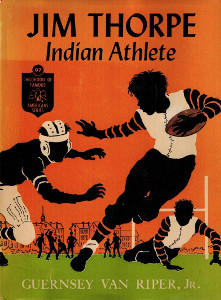Jim Thorpe: Indian Athlete

Author:
Guernsey Van Riper Jr.
Illustrator:
William Riley
Publication:
1956 by Bobbs-Merrill Company
Genre:
Biography, Non-fiction
Series:
Childhood of Famous Americans (Athletes)
Series Number: 97
Pages:
192
Current state:
This book has been evaluated and information added. It has not been read and content considerations may not be complete.
Book Guide
Search for this book used on:
When little Jimmy Thorpe first went to school, in 1893, on the Sac and Fox reservation in Oklahoma, he watched some of the big boys on the playground. One would toss a ball, and another would hit it with a stick. If he sent the ball flying, he could run between the stones that marked a diamond-shaped pattern on the ground. This was, Jimmy discovered, a game called baseball. He wished he were big enough to play—he'd like to try that game!
This is a story about the American Indian boy who was to try every sport, and excel in all. At six, Jimmy could ride bareback on the Thorpe horses, Rip and Tear. He could spear fish. He had brought down game with his bow and arrows. He could swim and wrestle and run and jump better than all the boys his age in the Sac and Fox tribe. When they played follow-my-leader, Jimmy always led—and always stumped his followers. So it wasn't long before Jimmy was leading the younger boys in baseball games at school.
All sports were easy for Jimmy—but also he knew it was his duty to take the lead. Wasn't he the great-great-grandson of the famous Chief Black Hawk? The elders of his tribe said young Jim looked and moved like the great warrior, though they doubted whether he would ever be as large and powerful. Jimmy's pa had told him he must strive to be like his ancestor. He must prove his courage and skill, win or lose with honor, to be a great chief of his own day. That way he could live up to his own Indian name, which meant "Bright Path."
Jimmy wondered how he could be a great chief now, when the Sac and Fox people were living peacefully on farms. What was left for a chief to do? Pa had told him to follow his own path, one step at a time. Not till Jimmy went farther away to school, in Kansas, could he discover where his path seemed to lead.
But at Haskell Institute he learned that one could be honored as a chief in sports. Jimmy loved all sports, particularly the game of football he learned there. It was more fun than baseball! Watching his games, the older athletes predicted, "That boy will be good, if he grows." Jimmy worried about his height. When he was chosen to enter Carlisle Institute, at fifteen, he was only four feet ten inches tall. But he was well built and muscular, a natural athlete. At Carlisle he did grow, at last—and was he good!
The final chapters of this exciting book dramatize Jim's college football days and the Olympic games of 1912 in Sweden, where Jim Thorpe was the famous American winner of both the Pentathlon and Decathlon. He went on to an almost legendary career in professional football—and to be named America's greatest football player and greatest all-round athlete of a half century.
His unequaled athletic record, his natural ability, his determination to be a great chief in the games he loved—these made Jim Thorpe one of the sports immortals. Guernsey Van Riper, Jr., who has written of other notable athletes for this series, tells one of his best and most colorful stories about the training of the young Indian athlete.
From the dust jacket
To view an example page please sign in.


